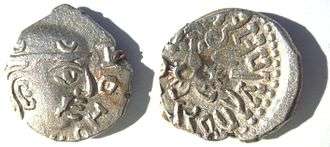Kumaragupta I
| Kumaragupta I | |
|---|---|
 Gold coin of Kumaragupta. | |
| 7th Gupta Emperor | |
| Reign | c. 414 – c. 455 CE |
| Predecessor | Chandragupta II |
| Successor | Skandagupta |
| Issue |
Skandagupta Purugupta[1] |
| Dynasty | Gupta |
| Father | Chandragupta II |
| Mother | Dhruvadevi |
| Gupta Empire 320 CE–550 CE | ||||||||||||||||||||||||||||||||||
|---|---|---|---|---|---|---|---|---|---|---|---|---|---|---|---|---|---|---|---|---|---|---|---|---|---|---|---|---|---|---|---|---|---|---|
|
||||||||||||||||||||||||||||||||||
Kumaragupta I, also known as Shakraditya[2] and Mahendraditya, was an emperor of the Gupta Empire in 415–455 CE. He was the son of his predecessor, Chandragupta II, and Dhruvadevi (also known as Dhruvasvamini).[3] He was an able ruler and retained, intact, the vast empire, which extended from Bengal to Kathiawar and from the Himalayas to the Narmada. He ruled efficiently for nearly forty years. However, the last days of his reign were not good. The Gupta Empire was threatened by the rebellion of Pushyamitras of central India and invasion of the White Huns. But, Kumaragupta was successful in defeating both threats and performed the Ashvamedha (horse sacrifice) to celebrate his victory. He issued new coins with images of his namesake, Lord Kumara.
Administrative set-up
During his reign, Chiratadatta was the governor of Pundravardhana Bhukti. A prince, Ghatotkachagupta was the governor of Eran and a third governor (or feudatory), Bandhuvarma was the ruler of Dashapura. The Karmadande inscription (436 CE) mentions Prithivishena, who was initially mantrin and kumaramatya (minister) of Kumaragupta I, but later became his mahabaladhikrita (general).[4]
Succession after Kumaragupta I

Obv: Bust of King Kumaragupta with cap decorated with crescents(derived from the coin design of the Western Satraps).[5]
Rev: Garuda bird, circled by legend in Brahmi "Parama-bhagavata rajadhiraja Sri Kumaragupta Mahendraditya" ("Most devout King of Kings Kumaragupta Mahendraditya").
Modern scholars are divided in opinion regarding the immediate successor of Kumaragupta I. While some believe that he was succeeded by his son Skandagupta, others contend that he was succeeded by his other son, Purugupta. Some even think that Skandagupta and Purugupta are the same person.[6]
The Junagadh rock inscription of Skandagupta mentions:[7]
…whom the goddess of fortune and splendour of her own accord selected as her husband, having in succession (and) with judgment skillfully taken into consideration and thought over all the causes of virtues and faults, (and) having discarded all (the other) sons of kings (as not coming up to her standard).
The full significance of this passage is obscure. It is, however, certain that the superior ability and prowess of Skandagupta in a time of crisis led to his choice as ruler in preference to other possible claimants after the death of Kumaragupta I and proud of his successes against the barbarians, Skandagupta assumed the title of Vikramaditya.
The continuous attacks of the Huns weakened the Gupta empire. Skandagupta died in 467 CE. After his death, the Gupta empire began to decline.
Dated inscriptions
An inscription on a figure of a yaksha from Mathura in the reign of Kumaragupta has been dated to 432 CE, and a pedestal (with no king's name on it, but presumably from Kumaragupta's reign) has been dated to 442 CE.[8]
The Bilsad inscription is the oldest record of his reign and it dates to Gupta year 96, which corresponds to 415 CE.
Decline of the Gupta Empire
Inscriptions prove that the Gupta sovereignty was acknowledged in the Jabalpur region in the Narmada valley as late as CE 528, and in North Bengal till CE 543–544. Kumaragupta II is believed to have been ruling in 473–474 CE and Buddhagupta from 476–495 CE. The Gupta empire began to disintegrate and by the middle of the sixth century CE, they had merely become petty chiefs.
The last known date of his reign occurs on an inscription on one of his silver coins, corresponding to 445 CE.
References
- ↑ Kulke, Hermann; Rothermund, Dietmar (2004). A History of India (Fourth ed.). Routledge. pp. 94–97. Retrieved 1 October 2014.
- ↑ Sukumar Dutt (1962). Buddhist Monks And Monasteries of India: Their History And Contribution To Indian Culture. George Allen and Unwin Ltd, London. p. 329. ISBN 81-208-0498-8.
- ↑ Agarwal, Ashvini (1989). Rise and Fall of the Imperial Guptas, Delhi:Motilal Banarsidass, ISBN 81-208-0592-5, pp.191–200
- ↑ Raychaudhuri, H. C. (1972). Political History of Ancient India, Calcutta: University of Calcutta, pp.500-1
- ↑ "Evidence of the conquest of Saurastra during the reign of Chandragupta II is to be seen in his rare silver coins which are more directly imitated from those of the Western Satraps... they retain some traces of the old inscriptions in Greek characters, while on the reverse, they substitute the Gupta type (a peacock) for the chaitya with crescent and star." in Rapson "A catalogue of Indian coins in the British Museum. The Andhras etc...", p.cli
- ↑ Mahajan, V. D. (1960, reprint 2007) Ancient India, New Delhi: S. Chand, ISBN 81-219-0887-6, pp.506-9
- ↑ An English translation of the text of the Junagadh Rock Inscription of Skandagupta
- ↑ Falk, Harry. (2004) "The Kaniṣka era in Gupta Records." Silk Road Art and Archaeology 10. Kamakura: The Institute of Silk Road Studies, pp. 167-176.
External links
| Regnal titles | ||
|---|---|---|
| Preceded by Chandragupta II |
Gupta Emperor 414–455 CE |
Succeeded by Skandagupta |

